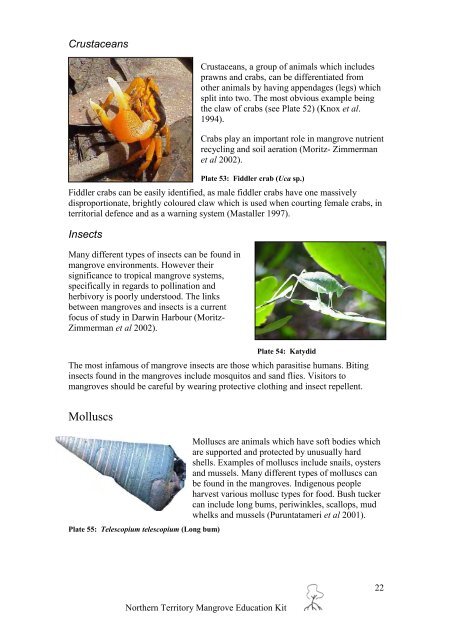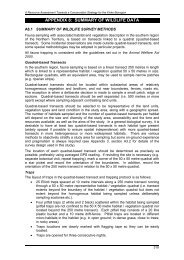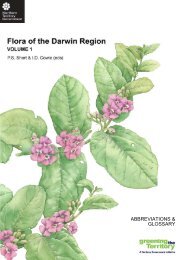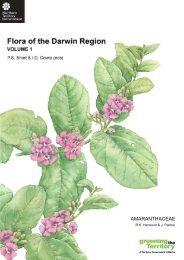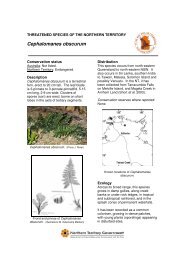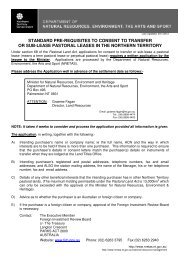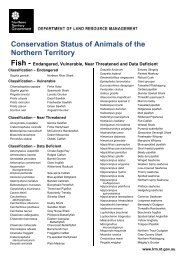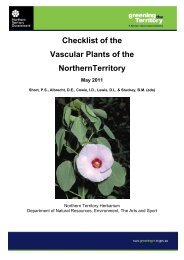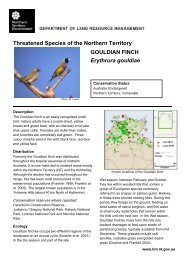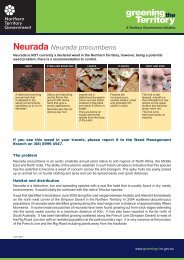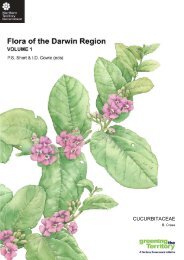Mangroves in the Northern Territory - Department of Land Resource ...
Mangroves in the Northern Territory - Department of Land Resource ...
Mangroves in the Northern Territory - Department of Land Resource ...
Create successful ePaper yourself
Turn your PDF publications into a flip-book with our unique Google optimized e-Paper software.
Crustaceans<br />
Crustaceans, a group <strong>of</strong> animals which <strong>in</strong>cludes<br />
prawns and crabs, can be differentiated from<br />
o<strong>the</strong>r animals by hav<strong>in</strong>g appendages (legs) which<br />
split <strong>in</strong>to two. The most obvious example be<strong>in</strong>g<br />
<strong>the</strong> claw <strong>of</strong> crabs (see Plate 52) (Knox et al.<br />
1994).<br />
Crabs play an important role <strong>in</strong> mangrove nutrient<br />
recycl<strong>in</strong>g and soil aeration (Moritz- Zimmerman<br />
et al 2002).<br />
Plate 53: Fiddler crab (Uca sp.)<br />
Fiddler crabs can be easily identified, as male fiddler crabs have one massively<br />
disproportionate, brightly coloured claw which is used when court<strong>in</strong>g female crabs, <strong>in</strong><br />
territorial defence and as a warn<strong>in</strong>g system (Mastaller 1997).<br />
Insects<br />
Many different types <strong>of</strong> <strong>in</strong>sects can be found <strong>in</strong><br />
mangrove environments. However <strong>the</strong>ir<br />
significance to tropical mangrove systems,<br />
specifically <strong>in</strong> regards to poll<strong>in</strong>ation and<br />
herbivory is poorly understood. The l<strong>in</strong>ks<br />
between mangroves and <strong>in</strong>sects is a current<br />
focus <strong>of</strong> study <strong>in</strong> Darw<strong>in</strong> Harbour (Moritz-<br />
Zimmerman et al 2002).<br />
Plate 54: Katydid<br />
The most <strong>in</strong>famous <strong>of</strong> mangrove <strong>in</strong>sects are those which parasitise humans. Bit<strong>in</strong>g<br />
<strong>in</strong>sects found <strong>in</strong> <strong>the</strong> mangroves <strong>in</strong>clude mosquitos and sand flies. Visitors to<br />
mangroves should be careful by wear<strong>in</strong>g protective cloth<strong>in</strong>g and <strong>in</strong>sect repellent.<br />
Molluscs<br />
Plate 55: Telescopium telescopium (Long bum)<br />
Molluscs are animals which have s<strong>of</strong>t bodies which<br />
are supported and protected by unusually hard<br />
shells. Examples <strong>of</strong> molluscs <strong>in</strong>clude snails, oysters<br />
and mussels. Many different types <strong>of</strong> molluscs can<br />
be found <strong>in</strong> <strong>the</strong> mangroves. Indigenous people<br />
harvest various mollusc types for food. Bush tucker<br />
can <strong>in</strong>clude long bums, periw<strong>in</strong>kles, scallops, mud<br />
whelks and mussels (Puruntatameri et al 2001).<br />
Nor<strong>the</strong>rn <strong>Territory</strong> Mangrove Education Kit<br />
22


